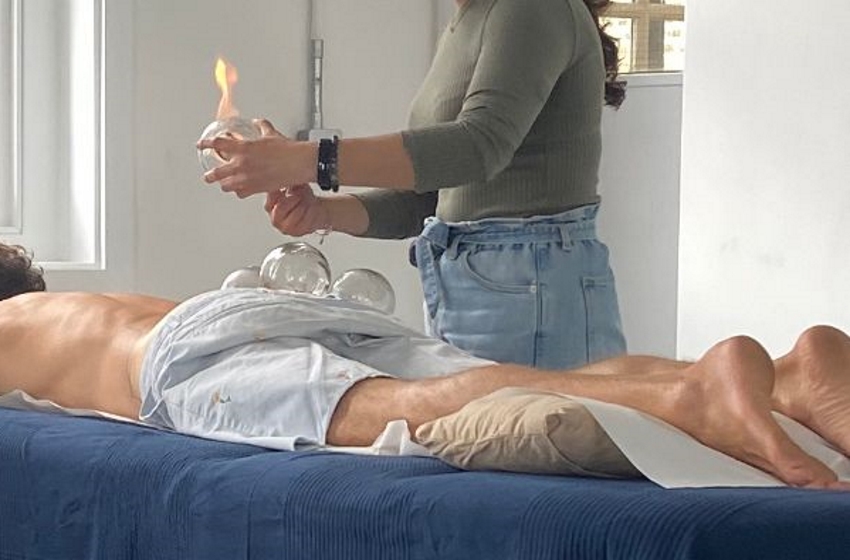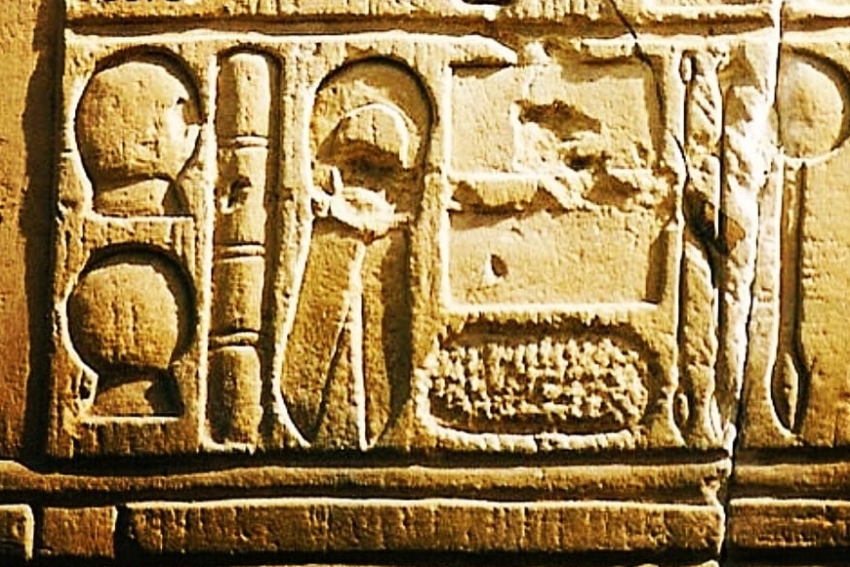At Bright Room Acupuncture Clinic we often use cupping in addition to acupuncture – patients love its relaxing effect on the muscles. It’s a standard part of our treatment of mucular-skeletal problems.
Cupping therapy is a traditional healing technique that has been practiced for centuries in various cultures around the world. It involves placing cups on the skin to create suction, which helps to improve blood flow, promote healing, and relieve pain. The cups are heated or suctioned onto the skin, creating a vacuum effect that draws the skin and underlying tissues upward into the cup. This suction stimulates blood flow, stretches muscles and connective tissues, and encourages the release of toxins.

What is cupping therapy?
In recent years, cupping therapy has gained significant popularity as a holistic healing modality. This ancient practice, rooted in traditional Chinese medicine, involves placing cups on the skin to create a suction effect. Beyond its association with athletes like Michael Phelps, cupping therapy offers a wide range of uses and benefits. At Bright Room, we offer cupping along side acupuncture, and find they work incredibly well together, especially for muscular-skeletal issues
Pain Relief and Muscle Recovery:
One of the primary uses of cupping therapy is to alleviate pain and facilitate muscle recovery. The suction created by the cups helps increase blood circulation to the affected areas, promoting healing and reducing inflammation. Cupping can effectively address various types of pain, including back pain, neck and shoulder tension, and even migraines. By stimulating blood flow and relaxing tense muscles, cupping therapy provides a natural and drug-free option for pain relief and recovery.
Stress Reduction and Relaxation (Approximately 100 words): In today’s fast-paced world, stress has become a prevalent issue. Cupping therapy can be a valuable tool for managing stress and promoting relaxation. The cups create a gentle pulling sensation on the skin, which helps to relax the body and calm the mind. This process stimulates the parasympathetic nervous system, inducing a state of deep relaxation and reducing stress levels. As a result, cupping therapy can have a positive impact on mental well-being, aiding in the management of anxiety and stress-related conditions.
Detoxification and Improved Circulation:
Cupping therapy is believed to enhance the body’s natural detoxification processes. The suction effect draws stagnant blood and toxins to the surface of the skin, allowing the lymphatic system to eliminate them more efficiently. This increased circulation and detoxification can have a beneficial impact on the body, improving overall health and vitality. Cupping therapy is often used to address conditions like cellulite, lymphedema, and even respiratory issues such as asthma and bronchitis.
Skin Health and Beauty:
Beyond its internal benefits, cupping therapy can also contribute to healthier, more radiant skin. The suction effect of the cups stimulates collagen production and increases blood flow to the surface of the skin. This process promotes skin rejuvenation, reducing the appearance of fine lines, wrinkles, and scars. Cupping therapy can also help treat various skin conditions, including acne and eczema, by improving circulation and supporting the body’s natural healing mechanisms.
What does cupping do – the Eastern perspective:
Restoring the Flow of Qi:
In Eastern medicine, cupping therapy is believed to restore the harmonious flow of vital energy, known as Qi (pronounced “chee”). According to this perspective, pain and illness arise when the flow of Qi becomes obstructed or imbalanced. Cupping therapy helps remove stagnation by creating a suction effect that draws out toxins, activates Qi circulation, and promotes the body’s innate healing abilities.
Balancing Yin and Yang:
Another fundamental concept in Eastern medicine is the balance between Yin and Yang, the complementary and opposing forces in nature and within the body. Cupping therapy is thought to restore this balance by adjusting the flow of Qi and blood. The cups are strategically placed on specific meridian points or energy pathways, balancing the Yin and Yang aspects of the body and restoring equilibrium.
Clearing Heat and Dampness:
In Eastern medicine, cupping therapy is often employed to address conditions associated with excess heat and dampness in the body. The suction created by the cups is believed to draw out excessive heat and dampness, which can manifest as symptoms like inflammation, swelling, or skin issues. By clearing these imbalances, cupping therapy aims to promote overall well-being and alleviate related symptoms.
Stimulating Acupoints and Meridians:
Cupping therapy is closely associated with acupuncture and acupressure, as both practices target specific points along the body’s meridians or energy channels. Cupping therapy stimulates these acupoints, activating the flow of Qi and facilitating the body’s natural healing processes. By applying cups to relevant areas, cupping therapy can help balance energy, relieve pain, and address a wide range of health conditions.
Regulating Organs and Systems: According to Eastern medicine, cupping therapy can have specific effects on various organs and systems in the body. Different cupping techniques, such as wet cupping or fire cupping, are utilized to address specific imbalances and activate corresponding organs. For example, cupping therapy can be used to support respiratory health, improve digestion, promote circulation, or enhance detoxification.

History of Cupping Therapy
While often associated with Traditional Chinese Medicine, the history of cupping extends beyond China, encompassing a rich tapestry of cultural and medical traditions. Cupping has a long history of use not only in Asia, but also in the Middle East, as well as Eastern Europe.
Cupping in Asia
The origins of cupping can be traced back to ancient civilizations in Asia, particularly in China and Egypt. Chinese medical texts dating back to the fourth century detail the therapeutic applications of cupping, referring to it as “horn method” due to the use of animal horns. Cupping was widely employed to balance the flow of Qi, the vital energy believed to govern health. It was seen as a means to stimulate blood circulation, alleviate pain, and treat a range of ailments, including respiratory and digestive disorders.
The Middle Eastern Legacy
The practice of cupping also found its place in the rich tapestry of Middle Eastern medicine. Ancient Persian and Arab physicians embraced cupping, attributing its therapeutic benefits to its ability to purify the body and restore harmony. Carvings and heiroglyphics indicate that cupping has been in use for at least 3500 years. The influential Persian physician, Avicenna, documented cupping’s healing properties in his medical compendium “The Canon of Medicine.” In this region, cupping gained popularity as a way to treat conditions such as musculoskeletal pain, skin diseases, and even emotional imbalances.
Eastern European Traditions
In Eastern Europe, cupping therapy became an integral part of traditional folk medicine. Historical records indicate that cupping was practiced in countries such as Russia, Bulgaria, and Poland. In these regions, cupping was applied to address various ailments, including rheumatism, respiratory conditions, and general wellness. Traditional healers employed a range of materials for the cups, such as glass, wood, or even animal horns.
How does cupping work – the Western Perspective
Increased Blood Circulation:
One of the primary mechanisms behind cupping therapy’s therapeutic effects is the promotion of blood circulation. The suction created by the cups causes blood vessels to dilate, leading to improved blood flow to the treated areas. This increased circulation delivers oxygen and nutrients to the tissues, promoting the healing process and reducing inflammation. Additionally, enhanced circulation helps remove metabolic waste and toxins, aiding in detoxification and promoting overall tissue health.
Triggering the Anti-inflammatory Response:
Cupping therapy has been found to trigger an anti-inflammatory response in the body. The suction applied through the cups stimulates the release of various chemical messengers, such as cytokines, that regulate inflammation. This can lead to a reduction in localized inflammation and pain. Furthermore, cupping therapy activates the body’s natural healing processes, including the production of anti-inflammatory substances, such as nitric oxide, that help modulate the immune response and promote tissue repair.
Neural Modulation:
Cupping therapy also exerts its effects through neural modulation, influencing the nervous system. The suction on the skin stimulates sensory receptors, which send signals to the brain, triggering a response. This can lead to pain relief by inhibiting pain signals and promoting the release of endorphins, the body’s natural painkillers. Moreover, cupping therapy can activate the parasympathetic nervous system, inducing a state of relaxation and reducing stress levels.
Fascial Release and Tissue Mobilization:
Another mechanism of cupping therapy is its impact on the fascial system and soft tissues. The suction effect created by the cups helps to release tension and adhesions within the fascia, a connective tissue that surrounds muscles and organs. This can improve tissue mobility, flexibility, and range of motion. Cupping therapy also targets myofascial trigger points, aiding in the release of muscle knots and promoting muscular relaxation.
